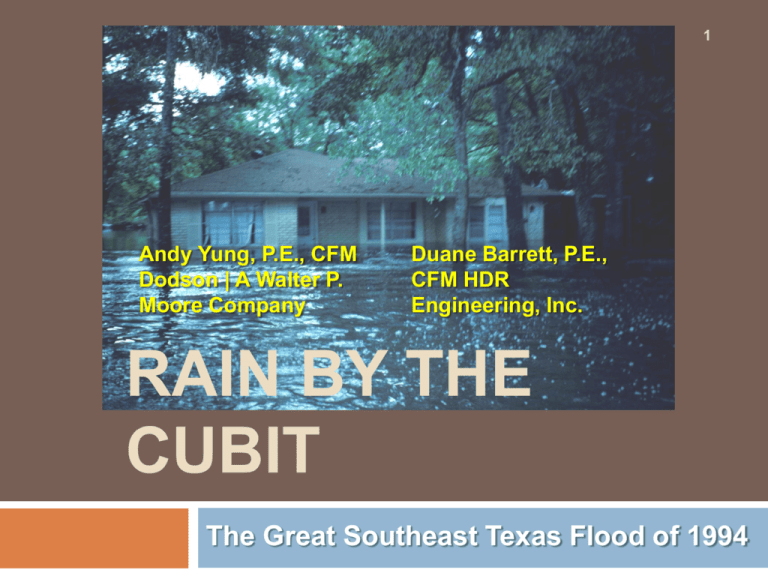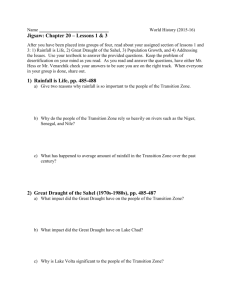Rain by the cubit - Texas Floodplain Management Association
advertisement

1 Andy Yung, P.E., CFM Dodson | A Walter P. Moore Company Duane Barrett, P.E., CFM HDR Engineering, Inc. RAIN BY THE CUBIT The Great Southeast Texas Flood of 1994 2 LLanite Llanite is found only in the vicinity of Llano, Texas. Although Llanite is an igneous rock, co-author Duane Barrett will always associate it with water! General Timeline 3 October 15, 1994 (Saturday) October 16, 1994 (Sunday) 3 Large Cell Develops Southwest of Waller, Texas - Early Morning 2 Flooding Overtops U.S. Highway 290 near Waller HCFCD Mobilizes Flood ALERT Activities October 18, 1994 (Tuesday) Rainfall Abates in the Early Morning Begins to Rebuild and Intensify in the Evening October 17, 1994 (Monday) Pacific Hurricane Rosa Meets a Gulf Coast Warm Front Over Texas Rainfall Begins Jet Stream Southward & Heavy Rainfall Comes to Harris County Most Bayous and Creeks in Harris County Report Major Flooding October 19, 1994 (Wednesday) 1 Aerial Reconnaissance Conducted Across Harris County The Sun Appears! Geography 4 The 1994 flood affected a huge geographic area covering 38 counties in southeast Texas. The map at right illustrates the extent of the affected area, which is roughly the size of the state of Maine. Lake Conroe Lake Livingston Lake Houston Meteorology 5 Remnants of Pacific Hurricane Rosa interacted with a warm front from the Gulf of Mexico, creating a boundary along within which rainfall events were entrained. A Real “Texas Flood” 6 The song “Texas Flood” by Stevie Ray Vaughan provides an appropriate musical backdrop for this amazing video created from radar images of the 1994 event. October 15-19, 1994 Rainfall Totals 7 Rainfall totals of over 20 inches were recorded at 4 gages within Harris County. More than 15 inches was recorded at 18 gages. Finally, more than 10 inches was recorded at 34 gages! 8 Berry Bayou at Forest Oaks Drive Rainfall Data - HCOEM Gage 320 10/20/1994 12:00 AM 10/19/1994 12:00 PM 10/19/1994 12:00 AM 10/18/1994 12:00 PM 10/18/1994 12:00 AM 10/17/1994 12:00 PM 10/17/1994 12:00 AM 10/16/1994 12:00 PM 10/16/1994 12:00 AM 10/15/1994 12:00 PM 15 10/15/1994 12:00 AM 10/14/1994 12:00 PM 10/14/94 12:00 AM Cumulative Rainfall (inches) Rainfall Data for HCFCD Gage 320 25 24 Hours 20 13 Inches of Rainfall in 24 Hours 10 5 0 9 Greens Bayou at Mount Houston Road Rainfall Data - HCOEM Gage 1600 10/20/1994 12:00 AM 10/19/1994 12:00 PM 10/19/1994 12:00 AM 10/18/1994 12:00 PM 10/18/1994 12:00 AM 10/17/1994 12:00 PM 10/17/1994 12:00 AM 10/16/1994 12:00 PM 10/16/1994 12:00 AM 10/15/1994 12:00 PM 15 10/15/1994 12:00 AM 10/14/1994 12:00 PM 10/14/1994 12:00 AM Cumulative Rainfall (inches) Rainfall Data for HCFCD Gage 1600 25 24 Hours 20 13 Inches of Rainfall in 24 Hours 10 5 0 10 Cedar Bayou at U.S. Highway 90 Rainfall Data - HCOEM Gage 1740 10/20/1994 12:00 AM 10/19/1994 12:00 PM 10/19/1994 12:00 AM 10/18/1994 12:00 PM 10/18/1994 12:00 AM 5 10/17/1994 12:00 PM 10/17/1994 12:00 AM 10/16/1994 12:00 PM 10/16/1994 12:00 AM 20 10/15/1994 12:00 PM 25 10/15/1994 12:00 AM 10/14/1994 12:00 PM 10/14/1994 12:00 AM Cumulative Rainfall (inches) Rainfall Data for HCFCD Gage 1740 35 30 21 Inches of Rainfall in Less Than 24 15 10 24 Hours 0 Watershed-Wide Rainfall 11 The storm event of October 1994 produced staggering rainfall amounts, especially considering the size of the area affected. Source: Steve Johnson, P.E. The average rainfall depth over the 2,880-square mile San Jacinto River watershed was 19.5 inches. The 1% annual chance rainfall 4day rainfall is 14.9 inches. A total of 1.9 million acre-feet of runoff passed through Lake Houston. The average runoff over the watershed was 12.7 inches. Area-Wide Rainfall 12 Rainfall was heavy over the entire 38-county area affected by the storm, as evidenced by the figure at right. The area affected measures roughly 300 miles x 170 miles. 9” 13” 23” 21” 29” 17” 12” 18” Reservoirs React 13 In response to the heavy rainfall over their respective watersheds, water levels in Lakes Conroe, Houston, and Livingston rose rapidly, and spillways went into operation. Atascocita Area on Lake Houston (Photo: HCFCD) Lake Livingston The Trinity River Watershed 14 Lake Livingston Watershed Area = 16,600 square miles at Lake Livingston The Lake Livingston discharge reached a maximum of 110,600 cfs . The maximum lake level was 134.38 ft, 3.38 feet above the normal pool elevation of 131.00 ft. All this despite that the storm affected only the lower portion of the watershed! (Images: USGS, TRA) Lake Conroe Division Systems Manager Ike Barrett arrived at the Lake Conroe dam early on the morning of October 17 to find the lake level approximately two feet above the tops of the tainter gates. Barrett immediately ordered the gates to be opened to prevent damage. 15 Lake Conroe Watershed Area = 448 square miles Lake Conroe reached a maximum level of 205.88 feet (4.88 feet above the normal conservation pool of 201.00 ft). A peak discharge of 56,000 cfs was recorded a short distance downstream of the dam. (Photo: SJRA) Watershed Area = 2,830 square miles 16 Lake Houston The Lake Houston discharge reached a maximum value of 359,000 cfs with a corresponding lake elevation of 52.8 feet, 8.3 feet above the crest elevation of the 3,160-foot long overflow spillway. (Photo: HCFCD) 17 Lake Houston Lake Houston Gated Section of Spillway (Photo: HCFCD) Rivers and Creeks Rise 18 Cypress Creek Channel 19 Cypress Creek Overflows Cypress Creek overflowed its banks, sending thousands of acre-feet of storm water cross-country to the Addicks and Barker Reservoir watersheds and inundating thousands of acres of land. (Photo: HCFCD) 20 Cypress Creek Inverness Forest Levee on Cypress Creek at the Hardy Toll Road (Photo: HCFCD) 21 Northgate Crossing Levee Maximum flood levels along Spring Creek exceeded FEMA 1% annual chance values by 4.0 to 4.5 feet. The Northgate Crossing levee was overtopped on October 18, 1994. This is one of only two levee systems in Harris County. (Photo: HCFCD) 22 Northgate Crossing Levee Northgate Crossing Levee and Pump House (Photo: HCFCD) 23 West Fork of the San Jacinto River West Fork San Jacinto River at U.S. 59 (Photo: HCFCD) Barges IH-10 24 Lower San Jacinto River San Jacinto River at I-10 (Photo: HCFCD) Record Stream Flows 25 Stream flows in excess of 1% annual chance values were recorded at 19 USGS gages within the affected area! New historical maxima were recorded at 25 of 43 stations! Peak Discharge Comparisons 26 The 1994 flood produced peak flows on the San Jacinto and Lavaca Rivers that exceeded historical maxima from much larger watersheds . Location Drainage Area (sq mi) Peak Discharge (cfs) Peak Discharge (cfs/sq mi) San Jacinto River D/S Lake Houston 2,880 360,000 125 Lavaca River at Edna, TX 817 150,000 184 Spring Creek at Riley-Fuzzel Rd. 420 78,800 188 Trinity River at Liberty, TX 17,500 135,000 7.7 Brazos River at Richmond, TX 45,100 300,000 6.7 27 Photos Banana Bend/Rio Villa Area Below Lake Houston (Photo: HCFCD) 28 Photos Apartments in Forest Cove Area (Photo: HCFCD) 29 Photos Little Cypress Creek at Cypress-Rose Hill Road (Photo: HCFCD) 30 Photos Toys-R-Us on U.S. 59 at West Fork San Jacinto River (Photo: HCFCD) 31 Photos U.S. 59 North Bound Feeder Road at West Fork San Jacinto River (Photo: HCFCD) Base of Power Transmission Tower Displaced 32 Photos Power Line Near the Upper End of Lake Houston on the West Fork of the San Jacinto River (Photo: HCFCD) 33 Photos Cypress Creek at Aldine-Westfield (Photo: HCFCD) 34 Photos West Fork San Jacinto River Near Lake Houston (Photo: HCFCD) 35 Photos Forest Cove Area near the West Fork San Jacinto River (Photo: HCFCD) “Allsafe Insurance” 36 Photos Cypress Creek at Huffmeister Road (Photo: HCFCD) 37 Pea Gravel Pea Gravel is found everywhere. Although this small stone is used primarily in gardening, co-author Andy Yung will always associate it with the massive flood of 1994! 38 The San Jacinto River Fire (October 20th) Breakage of pipelines across the river led to a fire that sent plumes of black smoke hundreds of feet into the air. (Photo: Houston Chronicle) 39 Photos San Jacinto River Shortcut across Banana Bend/Rio Villa Meander. This is near the location of exposed pipelines; note burned trees. (Photo: HCFCD) Conclusions 40 Extreme rainfall events will continue to occur. Are they “acts of God” that may be ignored, or should they be considered when establishing flood protection requirements? The adoption of criteria that exceed FEMA minimum requirements should be considered by communities to guard against severe events. Design of critical facilities should consider such extreme events. We must study and learn from these events. Improvements in predictive technology and warning systems must continue in order to reduce the loss of life that occurs during such extreme weather events. References 41 Public Agencies U.S. Geological Survey (USGS) National Oceanic & Atmospheric Administration (NOAA) Harris County Flood Control District (HCFCD) San Jacinto River Authority (SJRA) Trinity River Authority (TRA) Harris County Office of Emergency Management (HCOEM) Private Sources The Houston Chronicle Steve Johnson, P.E., CFM






